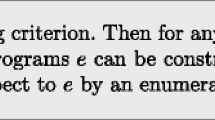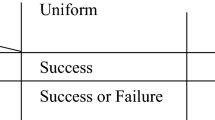Abstract
Nelson Goodman’s new riddle of induction forcefully illustrates a challenge that must be confronted by any adequate theory of inductive inference: provide some basis for choosing among alternative hypotheses that fit past data but make divergent predictions. One response to this challenge is to distinguish among alternatives by means of some epistemically significant characteristic beyond fit with the data. Statistical learning theory takes this approach by showing how a concept similar to Popper’s notion of degrees of testability is linked to minimizing expected predictive error. In contrast, formal learning theory appeals to Ockham’s razor, which it justifies by reference to the goal of enhancing efficient convergence to the truth. In this essay, I show that, despite their differences, statistical and formal learning theory yield precisely the same result for a class of inductive problems that I call strongly VC ordered, of which Goodman’s riddle is just one example.
Similar content being viewed by others
References
Chart, D. (2000). Schulte and Goodman’s riddle. British Journal for the Philosophy of Science, 51, 147–149.
Cornfield, D., Schölkopf, B., & Vapnik, V. (2005). Popper, falsification and the VC-dimension. Technical Report no. 145. Max Plank Institute for Biological Cybernetics.
Elgin, C. (ed). (1997). The philosophy of Nelson Goodman: Nelson Goodman’s new riddle of induction. New York: Garland.
Godfrey-Smith, P. (2003). Goodman’s problem and scientific methodology. Journal of Philosophy, 100, 573–590.
Goodman, N. (1946). A query on confirmation. Journal of Philosophy, 43, 383–385.
Goodman, N. (1954). Fact, fiction and forecast. Cambridge, MA: Harvard University Press.
Harman, G., & Kulkarni, S. (2007). Reliable reasoning: Induction and statistical learning theory. Cambridge, MA: MIT.
Hempel, C. (1965). Studies in the logic of confirmation. In Aspects of scientific explanation and other essays (pp. 4–46). New York: Free.
Kelly, K. (2004). Justification as truth-finding efficiency: how Ockham’s razor works. Minds and Machines, 14, 485–505.
Kelly, K. (2007). A new solution to the puzzle of simplicity. Philosophy of Science, 74, 561–573.
Kelly, K. (2007). Ockham’s razor, empirical complexity, and truth-finding efficiency. Theoretical Computer Science, 383, 270–289.
Popper, K. (1959). The logic of scientific discovery. New York: Routledge.
Scheffler, I. (1963). Anatomy of inquiry. New York: Knopf.
Schulte, O. (1999). The logic of reliable and efficient inquiry. Journal of Philosophical Logic, 28, 399–438.
Schulte, O. (1999). Means-ends epistemology. British Journal for the Philosophy of Science, 50, 1–31.
Schulte, O. (2000). What to believe and what to take seriously: a reply to David Chart concerning the riddle of induction. British Journal for the Philosophy of Science, 51, 151–153.
Stalker, D. (1994). Grue! The new riddle of induction. Chicago, IL: Open Court.
Thomson, J. J. (1966). Grue. Journal of Philosophy, 63, 289–309.
Vapnik, V. (2000). The nature of statistical learning theory. New York: Springer.
Author information
Authors and Affiliations
Corresponding author
Rights and permissions
About this article
Cite this article
Steel, D. Testability and Ockham’s Razor: How Formal and Statistical Learning Theory Converge in the New Riddle of Induction. J Philos Logic 38, 471–489 (2009). https://doi.org/10.1007/s10992-009-9111-0
Received:
Accepted:
Published:
Issue Date:
DOI: https://doi.org/10.1007/s10992-009-9111-0




